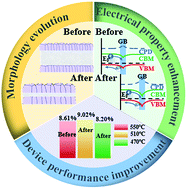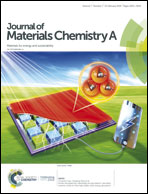Nanoscale electrical property enhancement through antimony incorporation to pave the way for the development of low-temperature processed Cu2ZnSn(S,Se)4 solar cells†
Abstract
Although low-temperature selenization technology offers several advantages in terms of production costs and beneficial composition profile controlling for Cu2ZnSn(S,Se)4 (CZTSSe) solar cells, excellent performance has not yet been achieved primarily due to the increased number of electronic disorders, smaller grain sizes, and more grain boundaries. In this study, a universal strategy for significantly increasing the power conversion efficiency (PCE) of low-temperature processed CZTSSe solar cells through directly dissolving the fluxing agent antimony into the as-prepared precursor solution is demonstrated. The key feature of this approach is that Sb atoms actually act without entering into the lattice and leave almost no residue within the absorber after taking effect. By appropriately adjusting the antimony incorporation concentration, the grain size, fine-grain layer thickness, local defect chemistry environment, and hole carrier concentration can be simultaneously improved, especially at low temperatures. More importantly, a larger band bending around the grain boundary (GB) is also observed by increasing the potential value from 40 mV to 100 mV after antimony incorporation, which can facilitate the GB-dominated carrier separation process. Due to the antimony-assisted morphology and enhancement in the nanoscale electrical properties, the CZTSSe device could maintain its performance at a lower temperature of 80 °C and directly decrease the selenization temperature down to 470 °C. This systematic study presents a new aspect for overcoming the challenges encountered at low temperatures, and our findings further support the great feasibility for the future application of low-temperature-processed CZTSSe photovoltaic technology to meet the industrial-scale production standards.



 Please wait while we load your content...
Please wait while we load your content...